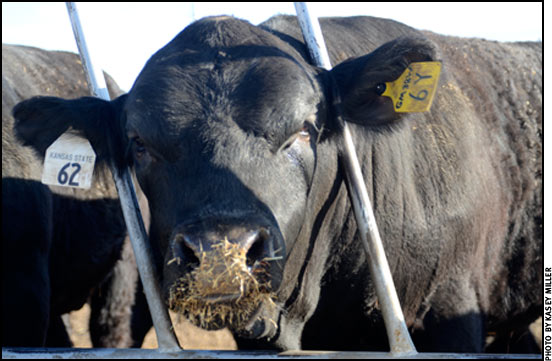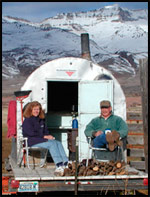MANAGEMENT...

Feeding Flavor
Research shows that beef can be an alternative source of omega-3.
Flavor is a huge variable that affects consumer acceptability of beef. Grain-fed and grass-fed beef have different flavors, which appeal to different sets of consumers. One of grass-fed beef's favorable attributes championed by proponents is that it contains more of the healthy omega-3 fatty acids, a good-for-you fatty acid more commonly found in fish. Research at Kansas State University (K-State) by Andrea Sexten has found that it is possible to increase omega-3 fatty acids in beef.
"What we're trying to do is show that we can have an alternative protein source that can be omega-3 enriched and not negatively impact flavor. It may be a little different, but it's not a negative impact," says Sexten. Read more.

Ron Torell with his wife, Jackie
Cow Camp Chatter
Artificial Insemination: Is it for your ranch?
Technology should not be oversold. A successful artificial insemination (AI) program takes time, labor, the facilities to properly process cattle multiple times, livestock handling skills and cows in adequate body condition and postpartum interval. It is imperative to have an understanding of the estrous cycle and heat synchronization protocol.
Time and effort is required for accurate heat detection. Unless you want 30% of your cows to be open, you will still need a cleanup bull or a second round of heat detection and AI. Following the process through diligently from the beginning, when the decision to AI is first made, to the end, when the last cow is bred, will yield the greatest success. Read more.
 Farm Business Success in Turbulent Times
Farm Business Success in Turbulent Times
Bob Milligan, a Cornell University professor emeritus of economics, challenged Cattlemen's College attendees to imagine what the beef industry, agriculture in general, and the U.S. economy will look like in 2042 — 30 years from now.
While no one has a crystal ball to the future, Milligan, who is today a consultant to various sectors of the ag industry, said he anticipates change will continue — and at an increasingly accelerated rate.
Milligan said it has put an increased sense of urgency on everything, but that can often create feelings of stress, pessimism and anxiety.
To alleviate those stressors — and address the urgency necessary to deal with turbulence in the marketplace, Milligan said leadership is required. Referencing a quote from the founder and CEO of Tires Plus, Milligan told producers, "Stop managing by the seat of your pants." Read more.
Facing a Growing Fly Problem
It appears we may have underestimated the impact stable flies have on the beef industry. They are known bloodsuckers capable of spreading infections and inflicting considerable aggravation upon cattle. But stable flies have often been considered a pest more common to operations where cattle are kept in confinement — feedlots and dairies. Horn flies and face flies are typically targeted as the summertime pests of most concern for cattle on range and pasture.
Twenty years ago, the cost of stable flies to U.S. cattle production was thought to be about $608 million per year. However, a report co-authored by USDA Agricultural Research Service (ARS) Entomologist David Taylor says stable flies may cost the country's cattle industries more than $2.2 billion annually, making them the most damaging insect pest affecting cattle. Research by Taylor and his colleagues suggests the annual economic impact to dairy and feedlot operations is $360 million and $226 million, respectively. The estimated impact to the cow-calf segment is $358 million. For stocker cattle on pasture, it's $1.3 billion. Read more.
 Controlling the Controllable
Controlling the Controllable
Forage specialist shares 10 keys to a profitable forage program.
Forages are going to play a more important role in this country, said Garry Lacefield, Extension forage specialist with the University of Kentucky. He told participants in the Dow AgroSciences forage seminar in Nashville Jan. 31 that there will always be grain in America's beef industry, but forages are going to become more important.
Lacefield said that to be profitable, income must be greater than expense. The challenge, then, is how to decrease expenses.
"As producers, we need to make sure we do the best job we can of controlling the controllable," said Lacefield. Feed costs, and the amount and quality of forages are potentially controllable. Read more.

Kris Ringwall
Beef Talk
The world of genetic marketing
Which calf was the most profitable? Was it a calf with a carcass value of $211.48 per hundredweight (cwt.), a carcass weight of 680 pounds (lb.) and a total value of $1,438.06, or a calf with a carcass value of $185.48 per cwt., a carcass weight of 1,017 lb. and a total value of $1,886.33?
Perhaps that statement is a little bold. However, to the typical cow-calf producer and the feedlot operator, to some extent, cattle marketing is challenging. The impact of those markets and the actual payout in relation to genetic plans is difficult to evaluate. However, markets work, and the free market is still the best available. Read more.
New Products
Industry affiliates provide a wide array of products and services to assist you on the farm and ranch. Here's an assortment of new products to hit the market recently.
- Prevent bovine pneumonia
- Broad-spectrum protection
- Weighing options
- Case IH work boot now available
- Battery-powered fence energizer
Angus Advisor
Click here for March herd management tips from cattle experts across the nation. Advice separated by region.
[Click here to go to the top of the page.]










